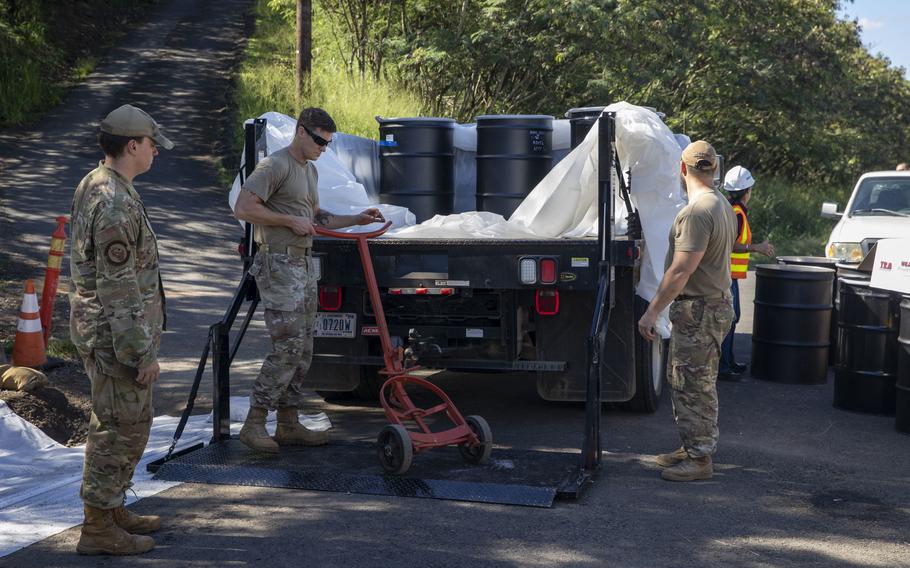
Airmen transport drums containing soil contaminated by toxic fire suppressant chemicals from the Red Hill fuel facility in Honolulu to a holding site at Joint Base Pearl Harbor-Hickam, Hawaii, Dec. 1, 2022. (Matthew Mackintosh/ U.S. Army)
(Tribune News Service) — Five months after hundreds of gallons of toxic fire suppressant spilled at the Navy's Red Hill fuel facility, sparking outrage from state health officials and environmentalists, military officials have yet to release their investigation or video of the spill.
At the same time, the U.S. Environmental Protection Agency's probe initiated in January into that incident, as well as other spills of the fire suppressant—called aqueous film forming foam, or AFFF—has resulted in little information being revealed publicly about the circumstances surrounding the incidents.
On Nov. 29 an estimated 1, 300 gallons of concentrated AFFF spilled from a pipe at Red Hill, prompting a major environmental cleanup that involved soil excavation and testing for a contaminant in the fire suppressant called PFAS, known commonly as "forever chemicals " because they break down so slowly in the environment. The EPA has recently proposed strict limits on the chemicals in drinking water because they've been linked to certain cancers and other health problems.
The spill touched off another round of controversy for the military, which has been under fire since a fuel spill from Red Hill in November 2021 contaminated the drinking water of military families. That spill, as well as historic spills from the facility, have contaminated the groundwater beneath Red Hill, and health officials and environmentalists have long worried that chemicals from the fuel could migrate into the island's public drinking water supply.
The AFFF spill fanned those environmental concerns, leaving the state Department of Health, as well as Honolulu Board of Water Supply and Hawaii Sierra Club, worried not just about fuel contamination of the aquifer, but PFAS.
The EPA's law enforcement arm subsequently initiated an inquiry into the AFFF spill and any other releases of the fire suppressant at Red Hill. The agency, which along with the state Department of Health has regulatory authority over Red Hill, specifically asked the Navy to describe the circumstances that led to each release, provide any video of the releases and maps that show the areas that were contaminated, among other information requests.
At the request of the Navy, the deadline was extended until March 15.
The EPA told the Honolulu Star-Advertiser that the Navy had met the deadline, but the Navy deemed some material, such as the maps, "controlled unclassified information, " preventing the EPA from releasing it. The Navy says it continues to review other material to see whether it needs to be redacted, even though the EPA told the Navy to identify any material that it claims is confidential prior to submitting the documents.
The Navy has indicated that some of the requested documents were already publicly available and has released a very brief description of the Nov. 29 spill, as well as two other spills at the facility—one on Dec. 7, 2019, that involved an estimated 1, 500 gallons of concentrated AFFF, and another spill on Sept. 29, 2020, that involved a 5, 000-gallon mix of AFFF and water.
But there's been nothing released that explains the circumstances surrounding the spills, and it's not clear whether the Navy has turned over information detailing the causes of the two prior incidents.
"The EPA is committed to seeking additional information not already provided by the Navy in response to our Request for Information, " EPA spokesperson Michael Brogan said in an email. "It's important that we understand the cause, response, and impact of each AFFF release in order to protect the health of Hawaii residents and the environment."
A Navy spokesperson indicated that the review of historic releases is ongoing.
"Once the Navy's review of historic releases is finalized, that information will be provided to regulators and the public, " said the spokesperson by email. "All documents and other information for public release will need to be reviewed for possible redaction. Again, that process focuses on thoroughness and accuracy."
Military officials have also provided no timeline on the release of their internal investigation of the Nov. 29 spill.
In early December, Adm. John Wade, commander of Joint Task Force-Red Hill, which is responsible for defueling Red Hill in order to permanently close it, announced that he had appointed Maj. Gen. Richard J. Heitkamp of the Army Reserve to investigate the spill, which was expected to take 30 days.
Wade told the Star-Advertiser in January that he had received a copy of the completed report and that he expected it, as well as video of the spill, to soon be released publicly.
This week a spokesperson for Joint Task Force-Red Hill said the investigation is still in process.
"The investigation is still pending, " he said. "Once the investigation and coordination has been finalized and approved for release, it will be made available."
Military officials declined to say whether a grand jury investigation involving Red Hill, which was first reported earlier this month by Hawaii News Now, has delayed the release of information relating to the AFFF spills.
"We do not comment on ongoing investigations, " said a Navy spokesperson.
(c)2023 The Honolulu Star-Advertiser
Visit The Honolulu Star-Advertiser
Distributed by Tribune Content Agency, LLC.